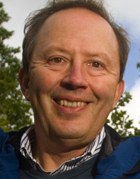Professor David Tilman was awarded the Dr A.H. Heineken Prize for Environmental Sciences 2010 because by combining mathematical theories, laboratory research and field experiments, he has made a fundamental contribution to the science of ecology, a branch of biology that studies the interplay between organisms and their environment.
When species in an ecosystem compete for a limited amount of food, which ones will survive and which ones will not? Resource competition theory uses a mathematical model to predict the winners and losers. David Tilman did much to develop this theory, which has been an essential part of virtually every textbook on ecology since the early 1980s. Tilman himself applied the theory to plants and came to a revolutionary discovery. He spent twenty years observing more than two hundred plots of grassland and kept precise species diversity and abundance records on each plot. He discovered that the plots where a wide variety of species co-habited clearly did much better under difficult circumstances – such as a period of drought -than plots with just a few species. He had shown for the first time that biodiversity makes an ecosystem more stable, demonstrating that protecting endangered species is important for the survival of earth’s ecosystems.
In recent years, Tilman has also devoted himself to studying sustainable farming methods, which are needed to meet the rapidly growing demand for food and energy. For example, he studied the advantages and disadvantages of different types of biofuels, demonstrating that native high-diversity grasslands could provide more energy per hectare than corn grain ethanol or soybean biodiesel. Not only is it economically more profitable to make biofuel from prairie grasses, but it is also more sustainable: grass absorbs more CO2 from the atmosphere and is not food crop for humans, unlike corn grain and soybeans.
Key publications
Tilman D. 1982. Resource Competition and Community Structure. Princeton University Press, Princeton
Tilman D. 1988. Plant Strategies and the Dynamics and Structure of Plant Communities. Princeton University Press, Princeton
Tilman D. & Downing J. 1994. ‘Biodiversity and stability in grasslands’. In: Nature367: 363-365
Tilman D., Cassman K.G., Matson P.A., Naylor R. & Polasky S. 2002. ‘Agricultural sustainability and intensive production practices’. In: Nature 418: 671-677
Tilman D., Hill J. & Lehman C. 2006. ‘Carbon-negative biofuels from low-input high-diversity grassland biomass’. Science 314: 1598-1600
Biography
G. David Tilman was born in Aurora, Illinois in 1949 and studied zoology at the University of Michigan. It was during his doctoral research on algae that he began to work on a mathematical model to predict the outcome of resource competition. He continued to work on his model, with success, after receiving his appointment at the University of Minnesota. In 1992, Tilman became director of University’s Cedar Creek Ecosystem Science Reserve, a nature preserve intended for ecological research, where he has been conducting his celebrated experiments since the early 1980s.
Tilman’s work has inspired many thousands of scientists around the world. The renowned Institute for Scientific Information has twice designated him the most highly cited environmental scientist of the decade (1990-2000 and 1996-2006). Tilman has been on dozens of boards, including for the National Science Foundation, the National Research Council and the United States’ President’s Council of Advisers on Science and Technology.
Video
Video interview with David Tilman, laureate of the Dr A.H. Heineken Prize for Environmental Sciences 2010
